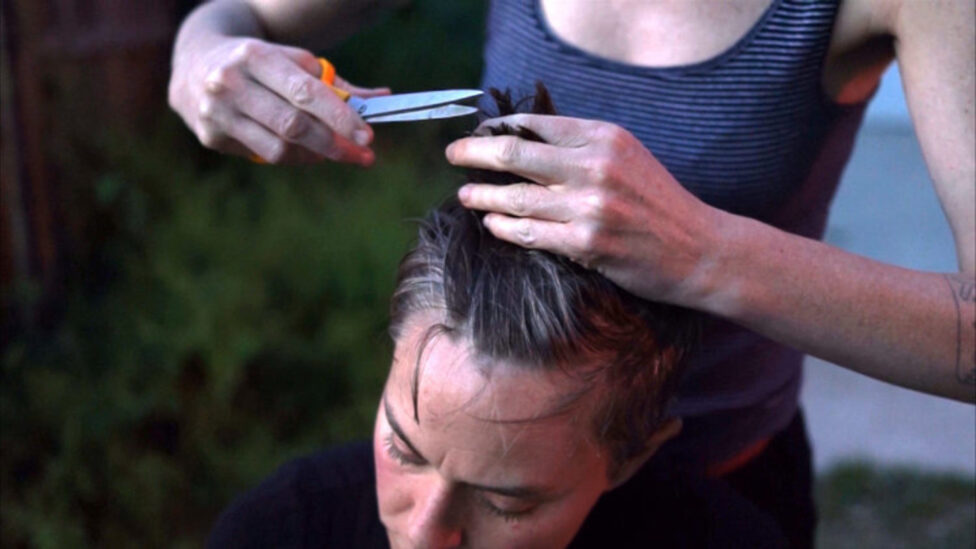Chris Domenick: In our first conversation, we talked a lot about tasks and their role. To get the ball rolling here, do you distinguish task from ritual?
Dani [Leventhal] ReStack: Yes. At least from the start. It starts with a task. The task may be banal or absurd, but there is intention, and the labor is real. If magic is apparent, we may repeat it as ritual. Or in editing it becomes ritual.
Sheilah [Wilson] ReStack: I agree that it starts as a task, mostly it is the task of making it happen. But what this makes me think is; when does a task become a ritual, and what elevates the action to ritual status? The images and shots stem from a desire, perhaps a sensibility to an environment, a color, a word, an action that you want to hold through the lens for a moment, or somehow interact your body with. I think for me the desire is so key to the work to make it happen, and it feels funny to put the word task on it. But maybe there I am just showing my own bias, thinking of the word task like a punch list, or the things I need to do to get ready for work, to get Rose ready for school, etc. Perhaps every word can be, or should be, re-inhabited. I acknowledge that I privilege the word ritual as being more mysterious, unknowable and as a portal to other worlds. Maybe I will say there are maybe different chakras of ritual/tasks. The making of Rose’s lunch is a certain kind of safety ritual of consistency, the ritual of putting a stone in your yoni is fantastical and strange.
I do like what Dani says about repetition being key to the becoming ritual. And the repetition can be the repeated viewing. We caress, or visualize, the thing we only did once into ritual state.
CD: The wedding, which was your primary project for some time, was packed with lots of rituals. You opened up a space for people to create their own rituals, and share them publicly. This made space for each person to share their strengths and their vulnerabilities, within this often fraught collective ritual.
SR: It was a humbling experience to try to inhabit and bend the container of the wedding to allow something that completely deviated from the norms of ‘do you take this person to be your lawful’ and tossing bouquets, yet also have to deal with so many logistical details. I loved the specificity of all the rituals from our beloveds that contributed to the ceremony. I also felt completely emotionally drained from the intensity of people from all the times of your life; childhood to now.
DR: From the night that I turned to Sheilah (in my sleep) and asked her if she wanted to share her life with me, we had an intent to invent our own wedding as a lesbian pandemonium rite of passage. We wanted not only to marry each other but to marry ourselves to everyone there, to marry the land, water and sky.
These things happened; Jared Buckheister brought us into his arms and whispered a message for us to play “telephone” with, then asked us to press stones into each other’s chests. Shayne Leventhal sang a Hebrew blessing over the wine. Samita Sinha sang an ancient Indian Baul song in full volume with bells on her feet. Bonnie Jones recited a poem. Sarah Rentz made a 5 color silk screen print that includes an aerial perspective of the site we were standing. Cathrine Wilson played violin while Matthew & Daniel Wilson and Rose sang The Blue. Carolyn Lambert and Paula Cameron made an elixir from the native plants of Nova Scotia, Nida Bikmen painted traditional symbols from Islam on our hands to ward off the evil eye. Daniel Berger read from a David Wojnarowicz text on desire and Jason Russo and Tara Autovino played their Courage Song. Brett wrote a poem called Devotion Coda about the exhilaration and work required of commitment. It was enchanted.
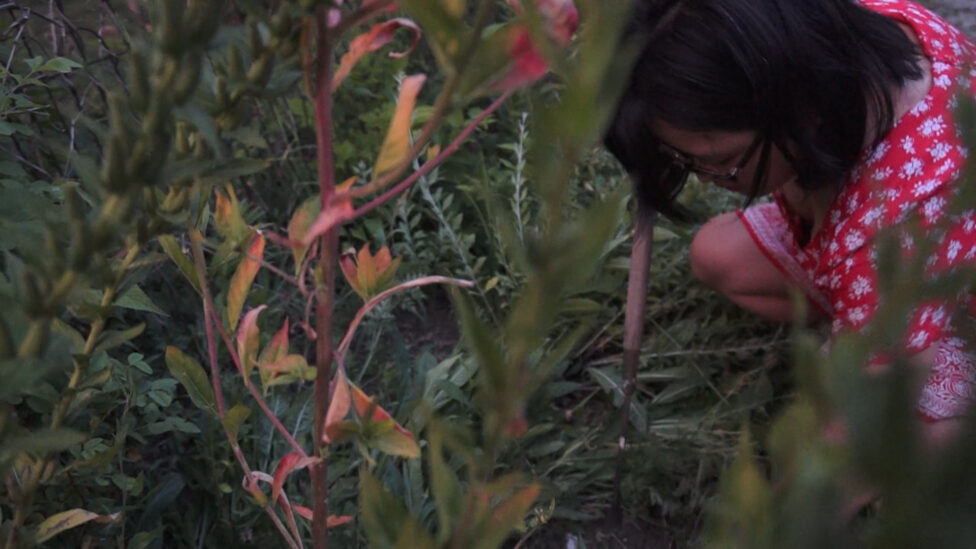
Still from Strangely Ordinary This Devotion (SOTD) 27 minutes, 2017. Courtesy of Video Data Bank.
CD: At the wedding, I was thinking about the role of ritual-maker vs ritual-viewer as both equally activated roles. Which makes me think about the problem of the passive viewer. Watching your work, I never feel passive. You have a way of equalizing the spectacle and spectator. 1. Do you think that is true? and 2. Is that a byproduct of your process or an intentional affect?
SR: I don’t know what Dani will say to this, but I think there is a heightened vulnerability that we both employ that doesn’t allow the spectator off the hook. There is a palpable feeling that we aren’t really hiding anything. This is exactly what we got. When that is in the air it cannot help but lead to curiosity, or discomfort, or a sense of being hyper present on the part of the spectator.
DR: Totally agree. And it’s also tied to Brechtian video editing.
CD: Can you talk about the role of Rose as both a character and a point of inspiration?
DR: Rose is a wonder. Rose invents with a fluidity that belongs only to children. We observe her and when possible shoot her.
SR: In our first conversation Dani thought it was uninteresting that I talked about the conflict I feel about including Rose. But I do feel conflicted. Part of me feels like there is a social and art world stigma around making work that pulls from the experience of motherhood, and particularly of using a child in the work. I think the word ‘using’ kind of says it all. That said, I feel like this is what I got, this is my life, this is the child I spend a lot of time with, this is my partner, here we are, inhabiting this world. For sure, Rose’s capacity to fly between the fantasy and the mundane is instantaneous and something to aspire towards for both of us. Hell, it should inspire everyone. Also, I love that you used the word character in the question, Chris, it is so on point. She is often trying on different roles, personas, voices and even sometimes I think allowing the character of emotion, or practicing who she is in relation to us, etc. I would like the work to honor her for who she is herself, as a participant in the lived and imagined worlds.
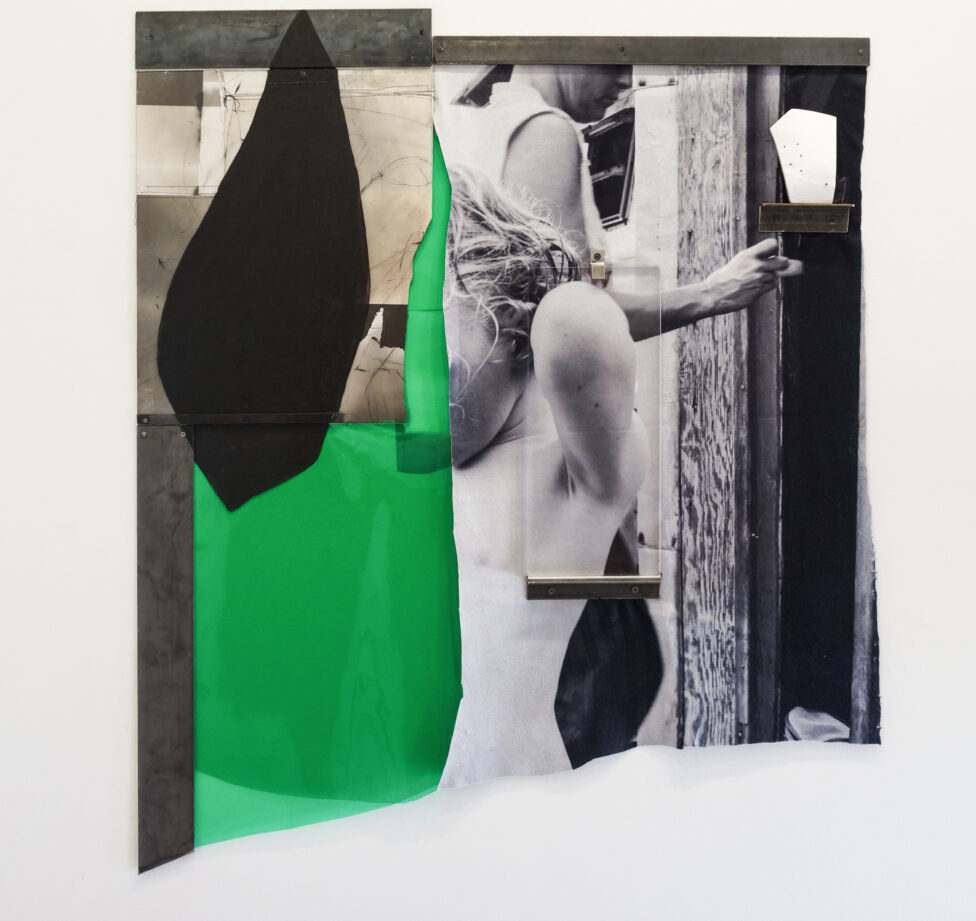
Star Cabin. Steel, acetate, plexi, clay, video still (SOTD) printed on fleece blanket. 45x39x3″. Courtesy of the artists.
CD: What are you two doing in Wellfleet?
SR: We’re installing the works we’ve been working on in the studio for the last year or so. I don’t know if you saw them. They are the felted blankets and the plexi, with steel and other materials.
CD: I may have seen them in progress.
DR: They finally came together. The images are stills from A Hand in Two Ways (Fisted). They’ll be installed with a bed inside a red tarped room to make a little place off the side of the gallery. The sound will seep out. What we’re interested in is a recognition, after you move through the space and you see the images, you then walk into the screening room at the end of the gallery, and you’re like, “Oh, I remember that. I didn’t know what that meant but now it kind of has a meaning that makes sense.”
CD: There will be the video as well?
SR: I don’t know if you would have seen it, but the video that a lot of the stills are pulled from is A Hand in Two Ways (Fisted), and it will be looping.
CD: Yes, I did see it.
DR: We’re working with the space; the gallery has a downstairs and an upstairs. You travel through the stills and then arrive at the sound. You go into the little screening room to lay on the bed to watch it. We’re curious about the opacity and the transparency of meaning. Like, what is this still image to you, and what is it when you encounter it as a moving image? How does it change? Because the video isn’t a straight narrative, it’s not like it’s suddenly gonna make complete sense, but it will make a different sense.
CD: Have you shown that video before?
DR: It was shown at Images in Toronto in a bedroom at a Motel 8. This is what inspired our interest in the bed. For viewers to watch shots in our bed, from the perspective of laying in a bed.
CD: One question I had, is the difference of each piece when it is installed? The difference between showing at a festival vs. a gallery vs. Leslie Lohman vs. The Whitney, how do you navigate that?
DR: Strangely Ordinary This Devotion (SOTD) is 27 minutes long, and its meaning is made progressively. That piece only shows in a cinema. We put the shorter works in other spaces. We know this cinephile named Ron Green, who was faculty in film at OSU, and he’s writing a book on ‘the loop.’ He says a true loop is a loop of time and space. The question of a seam, the way of editing that continues to provide in a look is a challenge.
SR: With installation work it depends on the conditions of the space, and our relationship to the space and community. In Wellfleet at Gaa Gallery, Erin Woodbrey gave us a feather, and I put it into one of the pieces. The incorporation of materials can be a way of paying homage, or acknowledging/incorporating the space and community. When we were in Chicago at Iceberg we went through alleyways to find materials for the projection installation, and at Columbus Museum of Art we found materials in the trash of the art handlers…
DR: For the projection drawings we manipulate the surface of the screen/surfaces to emphasize different aspects of the shapes. Rose’s hand becomes enlarged because we put it closer to the projector through using this piece of styrofoam.
CD: So you’re actually manipulating the screen?
SR: Yes. There is a sound component to those installations, as well. I think they become another articulation of narrative and time. Maybe like time as a sculptural entity, with this expansion and contraction shifting what you pay attention to, and how you move from one material to the next. This is similar to the way we’re working on House Becomes You. It’s how you sculpt the space, in this case the image, I guess it is similar to an edit in some ways. What materials do you put next to each other, and how does that change your perception of narrative or form, based on that juxtaposition?
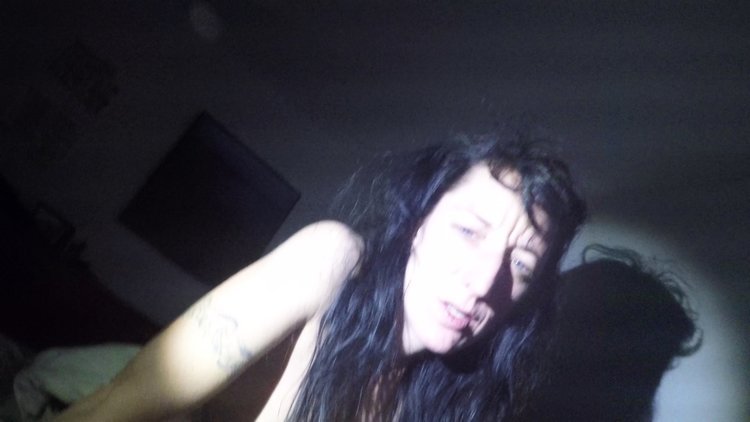
Still from A Hand in Two Ways (Fisted), 2017, 7 minutes. Courtesy of VTape.
CD: House Becomes You is the project in Wellfleet?
DR: Yeah, at Gaa in Wellfleet. With works like “Stack for Carrington’s Hyena” we call them projection drawings because the video has very little movement. It is a loop in a much different way. There’s nothing narrative about it. Maybe Rose’s hand will move, maybe her eyes will close for a while.
SR: I disagree. There is narrative to it! The narrative becomes what the viewer thinks is happening, or the construction of relationships between figures and forms. I think the narrative is implicit in the relationship of bodies and materials to one another. That becomes the viewers’ job to construct it.
DR: This is where we have different definitions of narrative, but I’m not going to fully disagree. The image is Rose, me, and Sheilah, stacked up, laying on top of each other in the kitchen, which is a domestic, functional space. What we’re creating with our bodies, there’s nothing functional about it. It’s not how we sleep, it’s not how we do stuff, it’s just this stack. And this is the stack that we’re tying to Anne Carson’s poetry.
CD: Dani, you’re saying it’s not linear in the same way SOTD is linear?
DR: Yeah, SOTD has a story. The stack is not a story. This is where we diverge a bit. Explain your idea, Sheilah, because its much tougher.
SR: This could be a whole other conversation! What I find funny is that Dani is so interested and committed to this idea of a linear narrative that progresses. Like one thing occurs, then another. At the same time, what is actually created is this circling around, this very experimental and fragmented narrative that is based on a felt response to the material of the image. I think that the work is exciting because it’s so anti-linear narrative.
DR: But there is still a story that drives.
SR: Of course, but I feel the story is the impetus for making the work. We have a story that we’ve thought of. Even in the case of us stacking up, there is a reason, a rationale, there is always something behind things, and then all of the images are the byproducts of that idea.
CD: And that feeds into the ways you are using fragments and stills in the Gaa show. The viewer walks around the space, they’re not necessarily having a linear experience, but rather, are experiencing everything in a fragmented way.
SR: Right, they’re gonna come in and see these blankets and images. I’m interested in images because they’re so highly readable, you get them. It’s a photo, it’s an image of bodies. I like that democracy of viewing, and how that catches you in recognition. We all respond to it, and then we are putting all these other materials and elements on top of the image that don’t necessarily make sense in relationship to the image. And some of the materials are pieces of clothing, or old photos, or steel, plexi, wigs. They come from all these different places and create this spontaneous construction. It is this constructed space, but it has a DNA of image, a recognizable thing. Yet it’s expanding into something else. Dani was saying that you go into the video, exit and you can understand it in a new way. I think similarly, you can walk to the side of one of the works on the wall and see what is behind it. Often in these works there is this front, back, and underneath quality. With a regular photo, it’s two-dimensional, the back is uninteresting. These pieces become richer not only because they are attached to the video, but because they are so dimensional. How do you hold all of this together? That, for me, is an interesting narrative. Because that is our impulse to hold things together, as humans; ‘I’m gonna make sense of this, god damnit.’
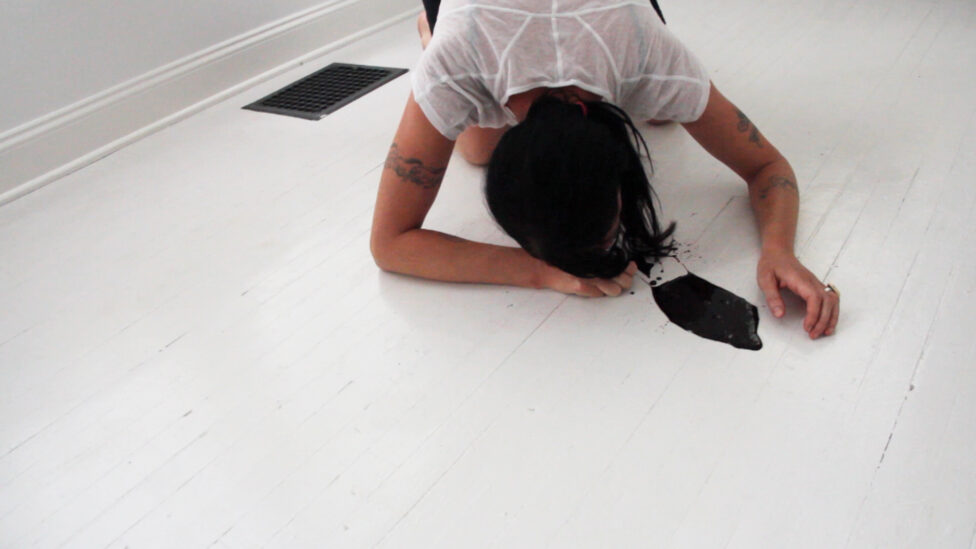
Still from Strangely Ordinary This Devotion (SOTD) 27 minutes, 2017. Courtesy of Video Data Bank.
CD: This conversation is making me think about your being connected to different crafts. Sheilah, you think a lot about the photograph and the image and its role. And Dani, I’ve heard you talk a lot about drawing and the role of drawing as a filmic experience. It’s interesting because sculpture becomes this intersectional ground where you can play out both of those things.
DR: That’s true.
SR: That’s an interesting way to think of it. There is also this thing of desire. I love the drawn mark, and Dani loves the image. There is this magnetic pull in thinking about how these things come together. There is a desiring to touch. People talk about collaboration as, it’s not me, it’s not you, it’s a third thing. I remember Teresa Hubbard talking about that. I agree, but it’s interesting to think about that in a material sense: it’s not this, it’s not that, it’s this in between form of materiality.
CD: How do you decide to involve other people in the films? I remember when I came over for the ceremony of the ReStack name change, and how you had invited people to participate in this fairly private ceremony, and that you were grappling with the idea of filming. How do you decide to draw the line between public and private, especially in these moments of real intimacy?
DR: Private is private. We are willing to be vulnerable on camera, to show reality, but there are things in our life that stay ours. These things are usually language based. No one needs to know the conversations of deep despair, fear or freedom. We can show that but we won’t record the conversation, that is private. Other people are unpredictable. We welcome that kind of magic.
We also strive for diversity in body, race, age, class, awareness. We seek people different from us which is how the complexity, richness and new registers develop.
SR: We are both aware of the biases of the art world, the image world, the western and capitalist world and would like to be part of breaking those patterns. Within the performance work there is something deeply unpredictable about other people, and what the experience of inviting them to participate in a ritual (like the one you mentioned, Chris) or the reading of the lesbian love letters for Shameless Light. This asking of community is a kind of intimacy that can be nerve wracking because of not being able to control other people, but it is also a sharing of the state of vulnerability.
With regards to the intimacy of ourselves, I am not so sure I see it so clear as ‘private is private’ as Dani does. There are sex scenes in SOTD and Fisted that are deeply private. I feel like as soon as the private becomes necessary to the story it is suddenly released from privacy. Like, if the private conversation becomes key to the work, it can then become enmeshed, necessary — and no longer seems so vulnerable. That said, there are times I am just like no way, get that camera away from me, I don’t want this moment to be even remotely thought of as possible for inclusion. Or, Dani’s repeated attempts to video Rose having a meltdown feel too horrifying to me, too traumatic for me to have to live through again.

Stack for Carrington’s Hyena, Iceberg Projects installation, 2017. Four-minute video of Dani, Sheilah and their daughter Rose stacked in the kitchen, barely moving. Voiceover of Ann Carson’s poem Stack can be heard here. Paper, Styrofoam, clothes, wood, screen, tape, hair, oil pastel, acrylic, glitter.
CD: Totally, I hear all of this. This makes me think of Pugwash, and Sheilah, your vows, and how site-specific they were. And how there is a turning inside out of public and private, and the vulnerability of that, but also the specific POWER of that. Pugwash is so interesting as a place.
SR: Pugwash is, in a way, interchangeable for any rural, small town Nova Scotia. I grew up in Caribou River, close to Pictou. At present the town of Pictou is experiencing even greater economic decline than when I was a youth, and there is a continuing fight against the pulp mill on the other side of the harbor. For a long time I hated the place itself, or blamed it, I guess. For the small mindedness, the homophobia, the lack of diversity. The land itself held this sadness for me, this anguish. It can still kind of make me catch my breath, a great loneliness can overwhelm me; this must come from the time of growing up and feeling so isolated.
That was this epiphany I had this summer, of how the land is open to all the stories, it is not the one judging. I wanted to lay this story of queer love on the shores of the land I grew up in, have the moss grow up over it, and allow it to feed into the historical sediment.
CD: You spoke about the trees of Pugwash as a kind of analogy, can you tell me more about that?
SR: I think the evergreens of Nova Scotia, and especially those along the coast, are these amazing survivors. They grow in the most radical lines, often dictated by prevailing wind direction. The rings of the tree are so close to each other because they spend so much time surviving there is little time for expansion of the trunk. The improbability of their shapes, the way they hold to the side of the cliff or make lines is formally interesting. It also makes me want to be that tenacious, to greet each season and its difficulties by bending and holding and see how that work changes Dani and I as a couple.
CD: There is a commitment to an intergenerational community happening through the films. Is that intentionally constructed? How do you think that contributes a politic to image culture at large?
SR: Definitely intentional… I mean first of all we aren’t such young whipper snappers anymore, so our world grows older. I think we both feel a commitment to honoring our elders, and that means a visual commitment to them as well. I know aging is the invisibility cloak of women, but I want to see. I want to see the things I do not see in our society and feel are important, necessary, and yes, part of a new world image order.
DR: I never want to go back to being 18. I was a mess and had no idea who I was. Most cameras want to look at pristine youth. I want to look at the raisin faces, the gnarled fingers, the chubby necks and snotty noses of children.
CD: SOTD is part of a trilogy. Is that true?
DR: Yes, and we’re completely overwhelmed with footage. Did we tell you about that shot we got when we were inseminating Sheilah at Brett’s house?
CD: Tell me again.
DR: We went there with an intent, and then, you know, after you put the sperm in, you’re supposed to have your legs up for a while. And I was playing with the flashlights and Sheilah started shooting video, and it was like, “Wow look at the shadow of your legs making a diamond shape”! And there was this ceiling fan making other shadows… Itt was unexpected, we never knew we would have such a shot. And it fits perfectly with our second of the trilogy- Future From Inside (FFI).
SR: We have a lot of these crossover moments. The inception of idea is something that we’re battling with in our own lives, and then the fantasy gets kind of spun around that and makes it more manageable to deal with. For instance, we have a huge conflict over whether or not to have another kid.
DR: For real.
SR: For real, that’s the real deal. It has been going on for a long time. The trilogy is about creating a space to work that out, and promising to somehow tie that to the making of work.
DR: Tell him the narrative of the second one.
SR: I’m hesitant to do so. Dani is very good at being specific about how it’s going to be this or we’re going up here or it’s going to be that. I’m more hesitant because I feel like there’s always this element of change. For instance, getting that footage at Brett’s house, who could’ve predicted that? No one. What I will say is we have a conflict. We are interested in this idea of journeying somewhere to find an answer. Right now the idea of the arctic is very appealing to me because it peels away layers of imagery I am accustomed to, and leaves us with just the question. I’ve never been there, so of course my conception of it is largely romantic.
DR: I gotta jump in. I like Sheilah’s understanding in her mind of what the arctic means, but it’s still tied to SOTD’s narrative, in that we’re talking about climate change and water crisis and the whole fantasy behind SOTD is that we must create these water children with our magic, who can survive the future. In FFI, we encounter another problem. To survive the precarity of the future without the crippling effects of anxiety, people must stay present. The ones to look to are the animals. If you observe an animal, they are present. So in FFI we will come to an agreement in the arctic: we’re in this orange tent and it’s glowing with a lantern, and I agree to having the baby but only if we infuse Sheilah’s fetus with a a fetus of an opossum. It is easy to get an opossum fetus, because it’s a marsupial. You can simply pluck it out of the pouch, no surgery necessary.
CD: Have you done that shot? Or is that a specific image you have in your mind?
DR: We’ve had our glass fetus fabricated but we haven’t done the shot. But I did set up a trap in the backyard to begin the process.
CD: That’s amazing.
DR: Stop rolling your eyes at me, Chris!
CD: No, no, I’m not rolling my eyes. I just think that it’s a beautiful tension that you two have. Dani you have the specificity of this event that is really clear to you and is contributing to the narrative, and Sheilah you’re taking that, but also recognizing that it needs room for movement.
SR: Because I want a kid and Dani doesn’t, our compromise is that we have a child that is part human / part animal.
DR: Staying with the trouble.
SR: That was my idea for the compromise, but the next thing I know there’s a trap in the backyard. It’s funny, this push pull push pull. And I want a story too.
DR: She just rolled her eyes at me – she doesn’t want a story!
SR: I do, too. Cancel the recording there!
CD: When you think about it like that, there’s a sort of limitation with the linear video, and the way that you two have internalized the narratives psychically, and you play them out in different ways. It’s weaved into the way that you two are interacting. and your ideas around the project, which is growing and unwieldy. It’s beyond the idea of the linear narrative. And more like, narrative is huge.
SR: That’s one of the things about collaboration. It feels very messy. I remember one time we were arguing really fiercely in front of someone. I think they got kind of afraid. I remember thinking “Oh sorry, we’re just working something out, don’t be afraid.” There is a gutsy visceral mess that we’re absolutely committed to, and also can’t avoid. Whether it’s in the lived realm or the making work realm.
DR: It is all tied to everyday life.
CD: Totally. That seems like a good place to stop.
Interview has been condensed and edited.

